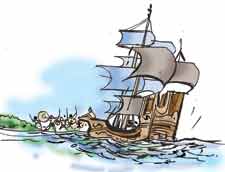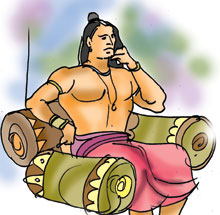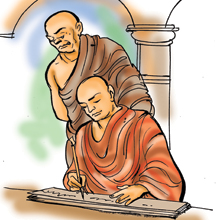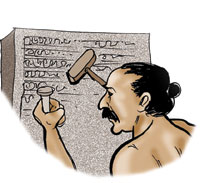Anagarika DharmapalaFrom Wikipedia, the free encyclopedia

Anagarika Dharmapala (1864 - 1933) was a leading figure in initiating two outstanding features of Buddhism in the twentieth century. He was a pioneer in the revival of Buddhism in India after it had been virtually extinct there for several centuries, and he was the first Buddhist in modern times to preach the Dharma in three continents: Asia, North America, and Europe.
Dharmapala was the
first anagarika - that is, a celibate, full-time worker for Buddhism - in modern times. It seems that he took a vow of celibacy at the age of eight and remained faithful to it all his life. Although he wore a yellow robe, it was not of the traditional bhikkhu pattern, and he did not shave his head. He felt that the observance of all the vinaya rules would have got in the way of his work, especially as he flew around the world.
Born David Hewavitarne in Colombo, Sri Lanka. Sri Lanka was then a British colony known as Ceylon, so Hewavitarne's state education was a Christian one: he attended Christian College, Kotte and the Colombo Academy. But the historical tide in Ceylon was beginning to turn in Buddhism's favour. In 1875 in New York, Madame Blavatsky and Colonel Olcott had founded the Theosophical Society. They were both very sympathetic to what they understood of Buddhism, and in 1880 they arrived in Ceylon, declared themselves to be Buddhists, and publicly took the Refuges and Precepts from a prominent Sinhalese bhikkhu. Colonel Olcott kept coming back to Ceylon and devoted himself there to the cause of Buddhist education, eventually setting up more than 300 Buddhist schools, some of which are still in existence.
The young Dharmapala helped Colonel Olcott in his work, particularly by acting as his translator. Dharmapala also became quite close to Madame Blavatsky, who advised him to study Pāli and to work for the good of humanity - which is what he did. It was at this time that he changed his name to Dharmapala (meaning "Guardian of the Dharma").
In 1891 Anagarika Dharmapala was on a pilgrimage to the recently restored Mahabodhi Temple, where Siddhartha Gautama - the Buddha - attained enlightenment at Bodh Gaya, India.[1] Here he experienced a shock to find the temple in the hands of a Saivite priest, the Buddha image transformed into a Hindu icon and Buddhists barred from worship. As a result, he began an agitation movement.[2]
The Mahabodhi society at Colombo was founded in 1891 but its offices were soon moved to Calcutta the following year in 1892. One of it's primary aims was the restoration to Buddhist control of the Mahabodhi Temple at Bodh Gaya, the chief of the four ancient Buddhist holy sites.[3][4] To accomplish this, Dharmapala initiated a lawsuit against the Brahmin priests who had held control of the site for centuries.[3][4] After a protracted struggle, this was successful, with the partial restoration of the site to the management of the Maha Bodhi Society in 1949.[3][4]
Due to the efforts of Dharmapala, the site of the Buddha's parinibbana (physical death) at Kushinagar has once again become a major attraction for Burmese Buddhists, as it was for many centuries previously. Mahabodhi Movement in 1890s held the Muslim Rule in India responsible for the decay of Buddhism in India. [5][6][7] Anagarika Dharmapala did not hesitate to lay the chief blame for the decline of Buddhism in India at the door of Muslim fanaticism. [8]
In 1893 Dharmapala was invited to attend the World Parliament of Religions in Chicago as a representative of "Southern Buddhism" - which was the term applied at that time to the Theravada. He was a great success and by his early thirties he was already a global figure, continuing to travel and give lectures and establish viharas around the world during the next forty years. At the same time he concentrated on establishing schools and hospitals in Ceylon and building temples and viharas in India. Among the most important of the temples he built was one at Sarnath, where the Buddha first taught. Here in 1933 he was ordained a bhikkhu, and he died at Sarnath in December of the same year, aged sixty-nine.
Dharmapala's voluminous diaries have been published, and he also wrote some memoirs.The above was adapted from Sangharakshita, Great Buddhists of the Twentieth Century, Windhorse Publications 1996, with permission.
Contributions to Sinhalese Buddhist NationalismDharmapala was one of the primary contributors to the Buddhist revival of the 19th century that led to the creation of Buddhist institutions to match those of the missionaries (schools, the YMBA, etc), and to the independence movement of the 20th century. DeVotta characterizes his rhetoric as having four main points: “(i) Praise – for Buddhism and the Sinhalese culture; (ii) Blame – on the British imperialists, those who worked for them including Christians; (iii) Fear – that Buddhism in Sri Lanka was threatened with extinction; and (iv) Hope – for a rejuvenated Sinhalese Buddhist ascendancy” (78). He illustrated the first three points in a public speech:
"This bright, beautiful island was made into a Paradise by the Aryan Sinhalese before its destruction was brought about by the barbaric vandals. Its people did not know irreligion... Christianity and polytheism [i.e. Hinduism] are responsible for the vulgar practices of killing animals, stealing, prostitution, licentiousness, lying and drunkenness... The ancient, historic, refined people, under the diabolism of vicious paganism, introduced by the British administrators, are now declining slowly away." (Anagarike Dharmapala, quoted in A. Guruge, Return to Righteousness: A Collection of Speeches, Essays and Letters of the Anagarike Dharmapala. Colombo: Ministry of Education and Cultural Affairs, 1965. 482)
He once praised the normal Tamil vadai seller for his courage and blamed the Sinhalese people who were lazy and called upon them to rise. He strongly protested against the killing of cattle and eating of beef.
***************************************************************************
Pioneer of Buddhist Revival Movement in South India Daily NewsLakshman JAYAWARDANE
BUDDHIST MISSIONARY: The origin of Buddhism in South India can be traced to Asoka’s Dharma Vijaya in the 3rd century B.C. Asoka’s rock edicts II and XIII enumerated the provinces of his own territory as well as abroad where he sent Buddhist missionaries.

These two contain accounts about his mission to Tamil Nadu and Sri Lanka. A golden age of Buddhism from the 2nd to the 7 century AD can be pictured from the Tamil classical works of Buddhist teachers of this period. Kanchipuram and Kaveripattinam were famous centres of Buddhism in Tamil Nadu. Until the 14th century AD Buddhism was flourishing in South India.
Angarika DharmapalaWith the spread of Jainism and Hinduism in the South, Buddhism began to decline. Until the 16th century some Buddhists stayed on at Nagapattinam. But even at this time, the city of Nagapattina, was a flourishing centre of Buddhism.
The Buddhists who remained in the South were gradually converted and became Hindus, Buddhism flourished for at least thousand years.
As a matter of fact Buddhism was not destroyed in India. But it was absorbed by Hinduism. According to statistics collected in 1981 only 735 people said they are Buddhists. But now things have changed due to the Buddhist Revival Movement in the South.
The 19th century saw a revival of interest in Buddhism in South India. The Buddhist revival movement in North India and South India began almost around the same time. The revival movement had its impact on scholarly work as well as socio political movements in South India.
Renaissance CommencedThe renaissance of Buddhism commenced in India, when British civil servants started bringing to high as monuments scattered all over the sub-continent. A number of rock-edicts and pillar inscriptions of Asoka were discovered in various parts of India commencing from 1750.
Alongside of these archaeological discoveries, studies on Buddhism Buddhology by scholars in India and abroad made great strides. Buddhist associations and societies were founded which engaged in revival activities by publishing Buddhism texts, editing journals and running schools.
The most important event in the history of the revival was the formation of the Maha Bodhi Society by Anagarika Dharmapala in 1891.
Dharmapala in AdyarDharmaduta Angarika Dharmapala devoted more than 40 years of his life of 69, to dharmaduta work in India. In December 1884 he set foot on Indian soil in the company of Madam Blaratsky and Col. Olcott. Dharmapala was twenty years old. They came to headquarters of the Theosophical Society in Adyar, Madras. Thus the foundation for his great career for dharmaduta activities was laid in the sacred soil of Adyar in Tamil Nadu.
Anagarika Dharmapala started the Maha Bodhi society on the 31st of May 1891 under the name of Buddhagaya Maha Bodhi Society, which for brevity’s sake became known as the Maha Bodhi Society. At that time he received an invitation from Madras asking him to make a visit.
This invitation came from none other than Col. Olcott.He accepted the invitation and came to Madras and attended the meeting which took place on 8th August 1898 at Royapettah in Madras. The Meeting was convened by Col. Olcott and Dr. Ayotheethos, a Buddhist leader living in Madras. This relationship started growing further.
A year later he received another invitation to come down to Madras to open a branch of the Maha Bodhi Society in South India. Thus on Sept. 17 1899 on his 35th birthday he arrived in Madras.
On the September 28 the Madras branch of the Maha Bodhi Society was inaugurated in the presence of a large gathering.
At this meeting a resolution was moved by M. Singaravelu Chetti to form a branch of the Maha Bodhi Society at Madras and thus the new branch came to existence. This is the first branch of Maha Bodhi Society.
The new branch was very active. Later Anagarika Dharmapala built a small Vihara in Perambur. The Maha Bodi Society office was also there.
Perambur Vihara of the Society was established with Rs. 3,000 sent by Dharmapala out of the funds donated by Mrs. Foster. Ven. Nilwakke Somananada Thera was the President of this new Vihara. It was Dharmapala who encouraged Somananda Thera to learn Tamil and brought him to South India to propagate Dhamma.
Ven. Nilwakke Somananda Thera is the first Buddhist monk from Sri Lanka to come and propagate Dhamma in Tamil Nadu. He was a great dharmaduta and a Buddhist scholar. He translated Dhammapada to Tamil.
It is regarded as the first translation of the Dhammapada to Tamil. He translated some other Buddhist books and another many pamphlets in Tamil. These books and pamphlets were published by Perambur Vihara. Within a short period Perambur Vihara became a very active Buddhist centre in Tamil Nadu.
Just after starting the Vihara Vesak was celebrated for the first time in South India. It is regarded as the “The very first attempt to propagate Buddhism in South India”. This historical event was the celebration of the 2443 Anniversary of Parinirvana of Lord Buddha.
A Tamil booklet on the “Life and Teaching of Bhagavan Buddha” was released on this historic day 2000 copies of its second edition were printed later indicting the great demand it caused after its release. An ancient Sanskrit work on caste system by Great Indian Scholar Asvagohosa was translated into Tamil and published by the Mahabodhi Society of Madras.
Active member of the Mahabodhi Society Prof. P. Lakshmi Narasu who became a Buddhist founded the Madras Buddhist Association Prof. Narasu wrote a book “The Essence of Buddhism” with an introduction by Dharmapala in 1907. The book became very popular and influenced South Indian intellectuals. The third edition of this book was published in 1948 with a preface by Dr. Ambedkar.
Writer is Counsellor (Information) in the Deputy High Commission of Sri Lanka in Chennai.
















